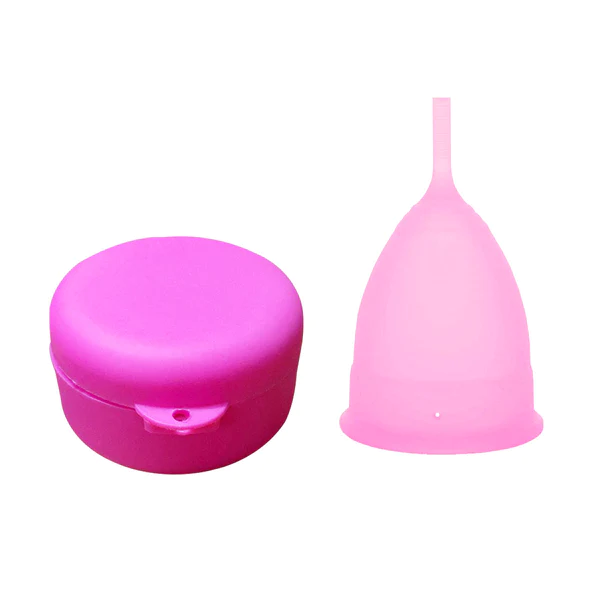Introduction:
In the realm of feminine hygiene, the silicone menstrual cup has emerged as a revolutionary and sustainable alternative to traditional disposable products. This innovative menstrual care solution has gained popularity among women worldwide for its eco-friendly nature, cost-effectiveness, and health benefits. In this article, we’ll delve into the intricacies of the silicone menstrual cup, exploring its origins, benefits, usage, and the impact it has on both the environment and women’s well-being.

Origins and Evolution:
The concept of menstrual cups dates back to the early 20th century, with various materials like rubber, latex, and silicone being experimented with over the years. The silicone menstrual cup, in particular, gained prominence in the last few decades due to its hypoallergenic properties and durability. Unlike its predecessors, silicone is a medical-grade material that is safe for internal use, making it an ideal choice for menstrual cups.
Benefits of Silicone Menstrual Cups:
- Eco-Friendly and Sustainable: One of the primary reasons for the growing popularity of silicone menstrual cups is their positive environmental impact. Traditional disposable menstrual products contribute significantly to landfill waste. In contrast, silicone cups are reusable and can last for several years with proper care. This not only reduces the amount of waste generated but also decreases the overall carbon footprint associated with menstrual care.
- Cost-Effective: While the initial investment in a silicone menstrual cup may seem higher than a box of disposable pads or tampons, the long-term cost savings are substantial. A single silicone cup can last up to ten years, eliminating the need for monthly purchases of disposable products. This financial benefit makes the silicone menstrual cup an economically viable option for women of all ages.
- Healthier Alternative: Silicone, being a medical-grade material, is non-toxic and hypoallergenic. This makes silicone menstrual cups a healthier choice for women with sensitive skin or allergies to latex, which is commonly found in other menstrual products. Additionally, unlike tampons, menstrual cups do not disrupt the natural pH balance of the vagina, reducing the risk of infections.
- Convenient and Reliable: Silicone menstrual cups offer a longer wear time compared to traditional products. Depending on the flow, a cup can be worn for up to 12 hours before needing to be emptied and cleaned. This makes them an excellent option for women with busy lifestyles, as they can go about their day without constant worry about changing pads or tampons.

Usage and Maintenance:
Using a silicone menstrual cup may seem intimidating at first, but with practice, many women find it more convenient than traditional options. Here’s a step-by-step guide to using and maintaining a silicone menstrual cup:
- Insertion: Fold the cup into a shape that suits you and insert it into the vagina, allowing it to unfold and create a seal. The cup sits below the cervix, collecting menstrual fluid rather than absorbing it.
- Wear Time: Silicone menstrual cups can be worn for up to 12 hours, depending on your flow. This allows for uninterrupted sleep and extended wear during the day.
- Removal and Emptying: To remove the cup, pinch the base to release the seal and gently pull it out. Empty the contents into the toilet, rinse the cup, and reinsert it. Cleaning with a mild, unscented soap and boiling the cup between cycles helps maintain hygiene.
- Storage: Between periods, store the silicone menstrual cup in its provided breathable pouch or container. Avoid using airtight containers to prevent moisture buildup.

Environmental Impact:
The environmental benefits of silicone menstrual cups are a driving force behind their widespread adoption. Traditional disposable menstrual products, including pads and tampons, contribute significantly to the plastic waste crisis. The average woman may use thousands of disposable products over her lifetime, creating a substantial environmental burden.
In contrast, silicone menstrual cups produce minimal waste. The manufacturing process of silicone has a lower environmental impact than the production of disposable menstrual products. Additionally, the longevity of silicone cups reduces the frequency of replacements, further decreasing the overall environmental footprint.

Challenges and Misconceptions:
Despite their numerous benefits, silicone menstrual cups are not without challenges and misconceptions. One common concern is the learning curve associated with proper insertion and removal. Some women may find it takes a few cycles to become comfortable with the process. However, numerous online resources, support groups, and user guides are available to assist those new to using menstrual cups.
Another misconception is that silicone menstrual cups are unhygienic. In reality, when used and maintained correctly, silicone cups are a sanitary and safe option. Boiling the cup between cycles effectively sterilizes it, and the medical-grade silicone material minimizes the risk of bacterial growth.

Conclusion:
The silicone menstrual cup represents a significant stride towards a more sustainable and woman-friendly approach to menstrual care. Its eco-friendly nature, cost-effectiveness, and health benefits make it a compelling choice for women seeking an alternative to traditional disposable products. As more women embrace this revolutionary shift, the collective impact on the environment and individual well-being is poised to create a lasting positive change in the realm of feminine hygiene. The silicone menstrual cup stands not only as a symbol of progress but as a tangible step towards a more sustainable and empowered future for women worldwide.
